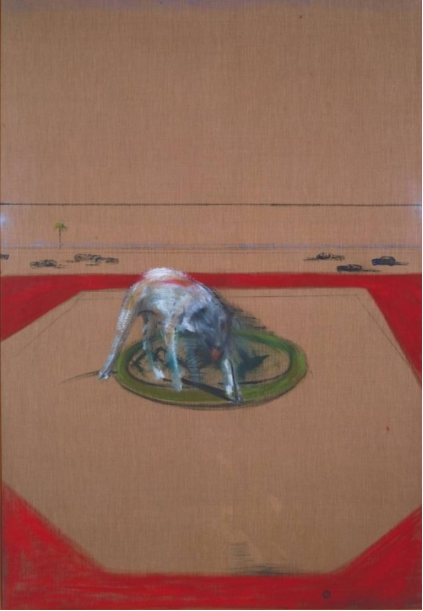MAY 9, 2014
In chapter one of his seminal text Deleuze asserts how Bacon composes the painting as ‘a kind of amphitheatre’, a stage which is used to to ‘isolate the figure’. The analogy of the canvas as a kind of theatre, a space in which drama can be acted out, on or through is hardly new, but Deleuze’s assertion that Bacon uses it specifically to isolate the figure is of interest.
Focus in on Bacon’s construction of theatrical spaces which provide platforms for figures to escape the limitations of narration and illustration. Bacon sets up spaces which, through their claustrophobia and cage like limits have the paradoxical effect of liberating the figures from the suffocating influence of the external narrating components in a painting. A figure tends normally to be in direct engagement with the elements which sit around a canvas, in the perimeters of a stage. It is a dialogue which starts a stream of associations which are inherently narrative. As such we tend to presume that a figures actions, reactions, emotional states and general being are a product of the other component parts of a painting. We presume a painting to be a network of elements which are reveling a series of cause and effects and which potentially point to wider causes and effects outside of the spatial and temporal framework of the image. This is exactly what Bacon’s paintings, and their architectural constructions (all cage like geometric spaces) fight against.
For Bacon painting need not take on other mediums in the game of storytelling. The figure need not be part of a whole, but can be an independent whole which we have to engage with directly and intensely. As Deleuze puts it:
‘Narration is the correlate of illustration. A story always slips into, or tends to slip into, the space between two figures in order to animate the illustrated whole. Isolation is thus the simplest means, necessary but not sufficient, to break with representation, to disrupt narration, to escape illustration, to liberate the Figure: to stick to the fact’

Bacon’s 1952 ‘Study of a Dog’ is a work which perfectly exemplifies this. For Bacon the dog is not only centre stage but is, to extend the analogy, the entire play. It spins and twists violently within itself, a ball of centrifugal force which almost breaks down its form, as if locked somewhere between live self autopsy and slow motion photography. The staging of the piece merely heightens the focus on this internalsied energy. It is a figure and an action which is utterly self reliant.
Kant wrote about the thing in itself. Post Kant writers took this as a launch pad for Romantic discussions over the central existential crisis of modernity, the figure islotated in the universe with no certainty of attachment to anything outside of its own corporeality. Bacon presents us with a Dog which in its disturbing and restless moment in flux gives us this human crisis its most base animal form, a dog chasing its tail as if it were something other, something outside of self to latch onto. It is a process central to his work, to the heighten intensity with which he presents our condition back to us, emptied of the safe opening space of narrative and left locked in the prison of existence.
No comments:
Post a Comment